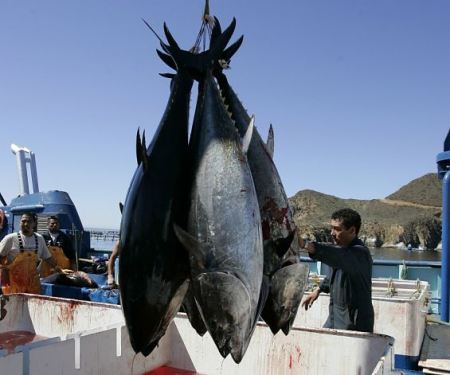VIA – SAMUEL WARDE.COM
That was over a year ago. The fish that were tested had relatively little exposure to the radioactive waste being dumped into the ocean following the nuclear melt-through that occurred at the Fukushima Daiichi plant in March of 2011. Since that time, the flow of radioactive contaminants dumping into the ocean has continued unabated. Fish arriving at this juncture have been swimming in contaminants for all of their lives.
Radioactive cesium doesn’t sink to the sea floor, so fish swim through it and ingest it through their gills or by eating organisms that have already ingested it. It is a compound that does occur naturally in nature, however, the levels of cesium found in the tuna in 2012 had levels 3 percent higher than is usual. Measurements for this year haven’t been made available, or at least none that I have been able to find. I went looking for the effects of ingesting cesium. This is what I found:
When contact with radioactive cesium occurs, which is highly unlikely, a person can experience cell damage due to radiation of the cesium particles. Due to this, effects such as nausea, vomiting, diarrhea and bleeding may occur. When the exposure lasts a long time, people may even lose consciousness. Coma or even death may then follow. How serious the effects are depends upon the resistance of individual persons and the duration of exposure and the concentration a person is exposed to.
The half life of cesium 134 is 2.0652 years. For cesium 137, the half life is 30.17 years.
The Fukushima disaster is an ongoing battle with no signs that humans are gaining the upper hand. The only good news to come out of Japan has later been proven to be false and was nothing more than attempts by Tokyo Electric Power Company (TEPCO) to mislead the public and lull them into a sense of security while the company searched vainly for ways to contain the accident. This incident makes Three Mile Island and Chernobyl pale in comparison. Those were nuclear meltdowns. A nuclear melt-through poses a much more serious problem and is one that modern technology doesn’t have the tools to address. Two and a half years later and the contaminants are still flowing into the ocean and will continue to for the foreseeable future.
The FDA assures us that our food supply is safe, that the levels of radiation found in fish samples are within safe limits for consumption. But one has to question if this is true and, if it is true now, will it remain true? Is this, like the statements issued from TEPCO, another attempt to quell a public backlash in the face of an unprecedented event that, as yet, has no solution and no end in sight?
As for me, fish is off the menu.
For the original post go here:
http://samuel-warde.com/2013/08/radioactive-bluefin-tuna-caught-off-california-coast/
 Become A Sponsor!
Become A Sponsor!If you have a product or service that is a good fit for our surf community, we have opportunities for you to sponsor this blog! Download our media kit now!

